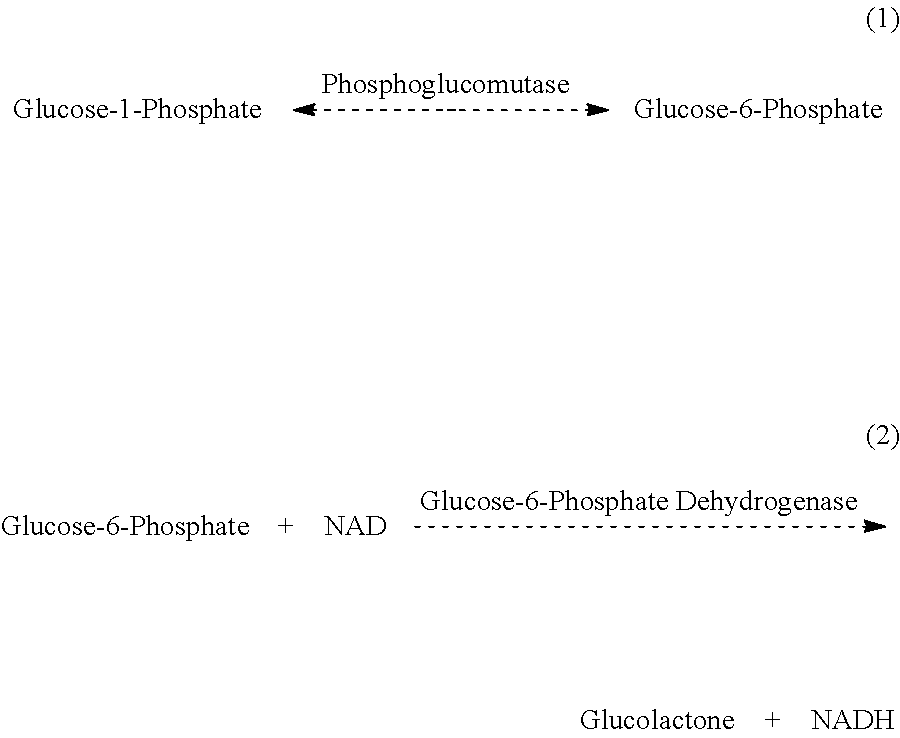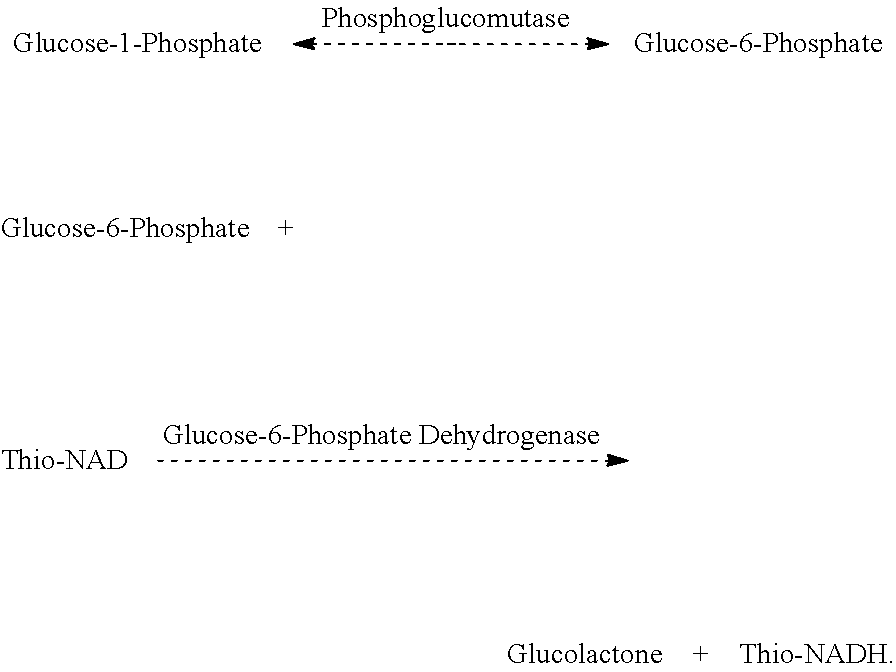Enzymatic determination of lithium ions using phosphoglucomutase
a technology of phosphoglucomutase and lithium ions, which is applied in the direction of biochemistry apparatus and processes, instruments, biological material analysis, etc., can solve the problems of high cost, high cost, and possible danger (flame photometric methods), and achieve the effect of sufficient amount and strength
- Summary
- Abstract
- Description
- Claims
- Application Information
AI Technical Summary
Benefits of technology
Problems solved by technology
Method used
Image
Examples
example 1
[0067]The reagent is configured as a two component liquid-stable reagent. The following is an example of a two-component reagent for measuring lithium ions in samples. There are many variations of this formulation which would be acceptable, as those skilled in the art of developing reagents will recognize.
Acceptable Preferred Reagent 1RangeRangeBuffer with pH of 7.8 pH 6-9pH 7-8.5(TRIS preferred at 0.1 mol / L)0.1 mol / L TRIS buffer0.01-0.5 mol / L0.05-0.25 mol / L0.125 mol / L malonic acid0.01-0.5 mol / L0.05-0.25 mol / L1.7 mmol / L thio-NAD0.1-3.0mmol / L0.5-2.5 mmol / L6 mmol / L magnesium sulfate0.1-50 mmol / L1.0-20 mmol / L5.33 mmol / L glucose-1-0.1-50 mmol / L1.0-20 mmol / Lphosphate0.3% bovine serum albumin0-10%0.01-1%0.05% sodium azide 0-5%0.01-1%0.13 μmol / L glucose-0-100 μmol / L0.05-0.5 μmol / L.1,6-disphosphate
AcceptablePreferredReagent 2RangeRangeBuffer with pH of 7.5 pH 6-9pH 7-8.5(TRIS preferred at 0.05 mol / L)0.05 mol / L TRIS buffer0.01-0.5 mol / L0.01-0.25 mol / L20 mmol / L magnesium 0.1-200 mmol / L1.0-100...
example 2
[0068]The lithium assay is run by adding one volume of sample to fifteen volumes of Reagent 1. After an incubation period, e.g., five minutes, three volumes of Reagent 2 are added plus one volume of diluent (distilled or deionized water). After a short lag phase absorbance readings are taken over a given time period, e.g., five minutes, and the rate of absorbance change per minute at an aforementioned wavelength is calculated.
[0069]When the sample, Reagent 1, Reagent 2, and diluent are all combined, the working reagent can have the following final concentrations and activity levels:
82.5 mmol / L TRIS buffer, pH 7.8
93.8 mmol / L malonic acid
1.28 mmol / L thio-NAD
7.5 mmol / L magnesium sulfate
4 mmol / L glucose-1-phosphate
0.24% bovine serum albumin
4.5% sorbitol
1500 units / L glucose-6-phosphate dehydrogenase
75 units / L phosphoglucomutase
0.1 μmol / L glucose-1,6-disphosphate.
[0070]The assay is calibrated using two standards. A protein-based “zero” standard, containing no lithium wi...
example 3
[0071]Below is shown some representative precision data, including the % coefficients of variation and standard deviations, demonstrating the recovery of lithium from serum based Controls.
PUM
 Login to View More
Login to View More Abstract
Description
Claims
Application Information
 Login to View More
Login to View More - R&D
- Intellectual Property
- Life Sciences
- Materials
- Tech Scout
- Unparalleled Data Quality
- Higher Quality Content
- 60% Fewer Hallucinations
Browse by: Latest US Patents, China's latest patents, Technical Efficacy Thesaurus, Application Domain, Technology Topic, Popular Technical Reports.
© 2025 PatSnap. All rights reserved.Legal|Privacy policy|Modern Slavery Act Transparency Statement|Sitemap|About US| Contact US: help@patsnap.com


